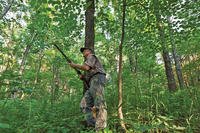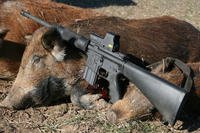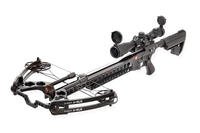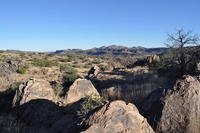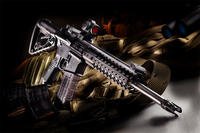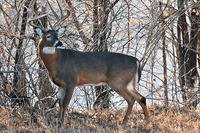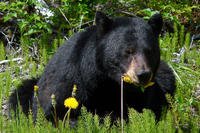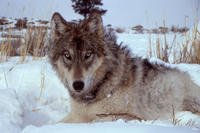There’s no better time to schedule and complete your preseason hunting chores than during summer.
by Mark Kayser
Regardless if you're self-employed, or work for another employer, your day revolves around a work schedule that keeps you hopping from one project to another. Without assignments, much of America's work wouldn't get completed or even started. For a successful muzzleloader season, look at the season in the same manner as you do your work. Schedule your preseason time wisely and your odds will increase exponentially.
There's no better time to schedule and complete your preseason hunting chores than during summer. Sure, it's hot and you might have to forego the air conditioning for awhile, but if you spend part of summer with blackpowder hunting season in mind, you won't need to rub the rabbit's foot before climbing into a treestand. To help you out, follow this gameplan of tasks and chores, which includes a timeframe for completion. Keep to the schedule for the best season yet.
June
Reacquaint Yourself With Landowners
If you don't keep up friendly relationships with landowners someone else might replace you in their good graces. Hunting properties are difficult, if not downright impossible, to find these days. Hunting clubs and leases, as well as outfitters, have tied up a lot of the best whitetail country. If you want to keep hunting on a property without coughing up outrageous fees, pay the landowner a friendly visit now and then. It's also a good idea to offer some show of gratitude and the best way is to offer up doing some chores or providing other services. Offer to mend a fence, spray weeds, paint a barn or help out during planting or harvest. If you're are a professional, offer your services such as accounting, legal advice, dentistry or even mechanic work. Even if a landowner doesn't want money for hunting privileges, he won't likely turn down a helping hand.
Plant a Food Plot
Depending on where you live, plant a food plot for the best time for your area. Choosing the right forage is imperative to drawing in a buck during hunting season. Brassicas are a great attractant that works from coast to coast. This plant is particularly a good choice for northern latitudes since member of the family are tolerant of early frosts and in fact lure deer better after a frost. Clovers or alfalfa are also good for most locations. The protein value in these meets minimum requirements, but better yet, deer love them. If you really want to spice up a food plot, add in some high-calorie favorites such as corn or soybeans.
Put Out Minerals
A few areas have sufficient minerals available to whitetails through the natural food they ingest, but most areas are lacking. Properly managed food plots can supply whitetails with the right mineral supply, but don't always bet on it. Drought and crop failure could leave whitetails lacking, so supply them with the needed requirements. The two most important minerals to include are calcium and phosphorous. Many packaged mineral supplements come in a 2-to-1 ratio in a calcium-rich formula.
Besides assisting in antler growth, mineral supplements also create perfect sites for trail cameras since deer visit the minerals frequently. Food plots can be accessed from various trails, but many mineral sites have a specific trail and it allows you to keep track of bucks and learn their haunts and travel routes.
July
Put Out Trail Cameras
Once your food plots and mineral sites begin drawing traffic from the resident whitetails, it's time to put out trail camera. Trail cameras are arguably the greatest innovation in whitetail hunting since the development of the modern tree stand. No other device has allowed us more of an in-depth view into the world and lifestyle of the whitetail. Summer ranks as one of the best times to capture bucks on camera and often reveals the best information for an autumn ambush. Bucks take on a lackadaisical nature and look for the best foods to beef up before the rut. Even mature bucks become more relaxed, oftentimes revealing themselves during daylight hours near food plots or on trails.
Sight in Your Muzzleloader
Every factory-produced firearm on the market achieves optimum performance with a particular ammunition load. To discover it you must test. For the average deer hunter, most companies recommend starting with a load such as 100 grains of Pyrodex or Triple Seven pellets or 100 grains of American Pioneer Powder sticks matched to a 295-grain bullet for a .50 muzzleloader. If you're shooting a .45, begin with a 223- or 225-grain bullet teamed with pellets equivalent to 100 grains. Experts at Connecticut Valley Arms have found that these are good pellet-and-bullet-weight combinations for deer hunting and not only perform well in CVA muzzleloaders, but most other factory muzzleloaders.
Scout for Bachelor Groups
Summer bucks travel in bachelor groups. Expect to see velvet-antlered whitetails visiting food plots and other attractive local crop fields. During this period whitetails might increase body weight by 20 percent or more. High-protein food plots lure bucks, but don't overlook corn, soybeans and acorn-bearing oaks. Scout at dawn and dusk, focusing on fields. Do your scouting with binocular or a spotting scope from afar.
August
Put Up Tree Stands
Once your trail cameras begin producing evidence of big bucks and their travel routes, use the information to begin placing tree stands prior to the opening day. Why do the work in August? Hopefully, intrusions into a buck's domain then will be forgotten by the time deer season arrives. In most climates and terrains, putting up a tree stand or clearing an area for a blind requires laborious, sweat-generating work that leaves lots of human scent. Time will erase such evidence of intrusion.
Summer also allows you to view the forest in its thickest wardrobe. With the woods in full foliage, you can clearly see the amount of trimming that needs to be undertaken to clear shooting lanes. Also, take time to redirect deer past your ambush site. Deer prefer to take the path of least resistance so give them what they want. Use a machete and whack out a winding path near your stand to provide deer a no-hassle, upwind travel route.
Scout Ground-Hunting Locations
Don't fall into a tree-stand rut. Ground blinds offer a comfortable and effective alternative for muzzleloader hunters, and they can be moved easily. Set blinds up along field edges, fence lines, open gates, and at water sources and near any other feature that funnel whitetails. Whitetails will notice a new structure in the neighborhood, and the key is to let them warm to it well before hunting season. To ensure the blind won't blow away, stake it solidly or anchor it to a fence post, hay bale or even a windmill frame.
Prep Your Truck and Gear
Finally, make sure your hunting rig is in working condition and organized for fast, effective hunting. Check your maintenance log to ensure everything is in working order. If you'll be encountering off-road conditions, you might want to look into beefing up the suspension and accessories with shocks and a grill guard.
Organizing your truck may sound easy, but when it comes time to hunt it seems like you're always searching for a certain call, binocular or gloves that were misplaced. Solve that problem with tool boxes, storage totes or upgrading to specialized truck box inserts. These units include long drawers that pull out and allow you to customize inserts to hold muzzleloaders, shotguns, bows and all your gear. Some models also are rugged enough to hold the weight of a four-wheeler when loaded on top.
Whether you work on a schedule or not, it makes perfect sense to plan for the upcoming muzzleloader season using a scripted list of chores. Keeping to that schedule will put the odds in your favor next deer season.
